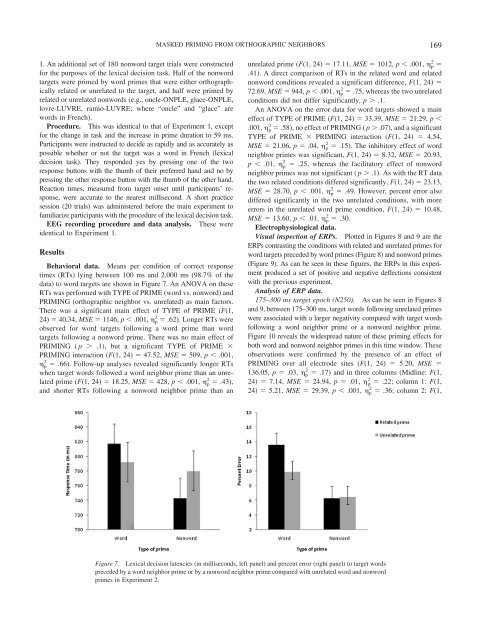Masked Priming From Orthographic Neighbors: An ERP Investigation
Masked Priming From Orthographic Neighbors: An ERP Investigation
Masked Priming From Orthographic Neighbors: An ERP Investigation
You also want an ePaper? Increase the reach of your titles
YUMPU automatically turns print PDFs into web optimized ePapers that Google loves.
MASKED PRIMING FROM ORTHOGRAPHIC NEIGHBORS1691. <strong>An</strong> additional set of 180 nonword target trials were constructedfor the purposes of the lexical decision task. Half of the nonwordtargets were primed by word primes that were either orthographicallyrelated or unrelated to the target, and half were primed byrelated or unrelated nonwords (e.g., oncle-ONPLE, glace-ONPLE,lovre-LUVRE, ramio-LUVRE; where “oncle” and “glace” arewords in French).Procedure. This was identical to that of Experiment 1, exceptfor the change in task and the increase in prime duration to 59 ms.Participants were instructed to decide as rapidly and as accurately aspossible whether or not the target was a word in French (lexicaldecision task). They responded yes by pressing one of the tworesponse buttons with the thumb of their preferred hand and no bypressing the other response button with the thumb of the other hand.Reaction times, measured from target onset until participants’ response,were accurate to the nearest millisecond. A short practicesession (20 trials) was administered before the main experiment tofamiliarize participants with the procedure of the lexical decision task.EEG recording procedure and data analysis. These wereidentical to Experiment 1.ResultsBehavioral data. Means per condition of correct responsetimes (RTs) lying between 100 ms and 2,000 ms (98.7% of thedata) to word targets are shown in Figure 7. <strong>An</strong> ANOVA on theseRTs was performed with TYPE of PRIME (word vs. nonword) andPRIMING (orthographic neighbor vs. unrelated) as main factors.There was a significant main effect of TYPE of PRIME (F(1,24) 40.34, MSE 1146, p .001, 2 p .62). Longer RTs wereobserved for word targets following a word prime than wordtargets following a nonword prime. There was no main effect ofPRIMING ( p .1), but a significant TYPE of PRIME PRIMING interaction (F(1, 24) 47.52, MSE 509, p .001, 2 p .66). Follow-up analyses revealed significantly longer RTswhen target words followed a word neighbor prime than an unrelatedprime (F(1, 24) 18.25, MSE 428, p .001, 2 p .43),and shorter RTs following a nonword neighbor prime than anunrelated prime (F(1, 24) 17.11, MSE 1012, p .001, 2 p .41). A direct comparison of RTs in the related word and relatednonword conditions revealed a significant difference, F(1, 24) 72.69, MSE 944, p .001, 2 p .75, whereas the two unrelatedconditions did not differ significantly, p .1.<strong>An</strong> ANOVA on the error data for word targets showed a maineffect of TYPE of PRIME (F(1, 24) 33.39, MSE 21.29, p .001, 2 p .58), no effect of PRIMING ( p .07), and a significantTYPE of PRIME PRIMING interaction (F(1, 24) 4.54,MSE 21.06, p .04, 2 p .15). The inhibitory effect of wordneighbor primes was significant, F(1, 24) 8.32, MSE 20.93,p .01, 2 p .25, whereas the facilitatory effect of nonwordneighbor primes was not significant ( p .1). As with the RT datathe two related conditions differed significantly, F(1, 24) 23.13,MSE 28.70, p .001, 2 p .49. However, percent error alsodiffered significantly in the two unrelated conditions, with moreerrors in the unrelated word prime condition, F(1, 24) 10.48,MSE 13.60, p .01, 2 p .30.Electrophysiological data.Visual inspection of <strong>ERP</strong>s. Plotted in Figures 8 and 9 are the<strong>ERP</strong>s contrasting the conditions with related and unrelated primes forword targets preceded by word primes (Figure 8) and nonword primes(Figure 9). As can be seen in these figures, the <strong>ERP</strong>s in this experimentproduced a set of positive and negative deflections consistentwith the previous experiment.<strong>An</strong>alysis of <strong>ERP</strong> data.175–300 ms target epoch (N250). As can be seen in Figures 8and 9, between 175–300 ms, target words following unrelated primeswere associated with a larger negativity compared with target wordsfollowing a word neighbor prime or a nonword neighbor prime.Figure 10 reveals the widespread nature of these priming effects forboth word and nonword neighbor primes in this time window. Theseobservations were confirmed by the presence of an effect ofPRIMING over all electrode sites (F(1, 24) 5.20, MSE 136.05, p .03, 2 p .17) and in three columns (Midline: F(1,24) 7.14, MSE 24.94, p .01, 2 p .22; column 1: F(1,24) 5.21, MSE 29.39, p .001, 2 p .36; column 2: F(1,Figure 7. Lexical decision latencies (in milliseconds, left panel) and percent error (right panel) to target wordspreceded by a word neighbor prime or by a nonword neighbor prime compared with unrelated word and nonwordprimes in Experiment 2.
















